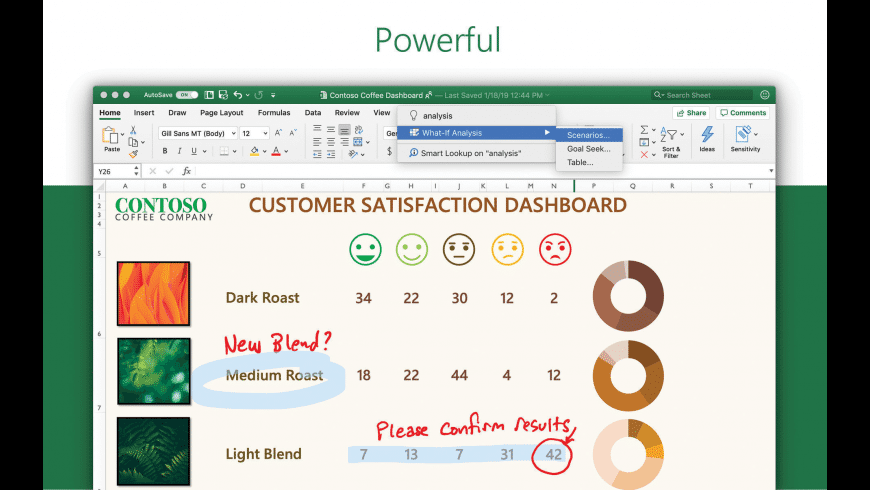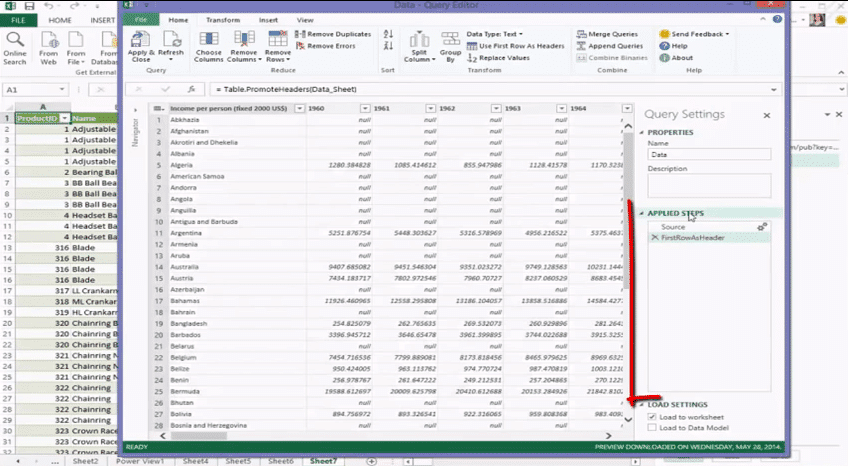Refreshing Power Query queries. Click on the Data tab of the ribbon then choose Refresh All. Right-click on your query table then click Refresh. Right click on your PivotTable then click Refresh Data. Use a VBA script. Power Query works across several Microsoft products, so whatever you learn for Power Query in Excel can be applied to Power BI and other products. Custom connectors Easily extend Power Query by creating your own connectors and data transformations if you need to, that can also easily be shared and used by others. Apr 08, 2020 In this video, we will understand the logic on how to combine sheet code works in Excel For Mac & Windows. Buy Office365 (Affiliate Link): https://microsoft.
- Power Query Excel 2019 Mac
- Microsoft Power Query Excel
- Microsoft Power Query Para Excel Mac
- Microsoft Power Query Excel Mac Download
- Microsoft Power Query Excel Mac 2017
Do you often import data into Excel? Do you ever need to shape your data before you analyze it and build your reports? We are excited to let you know that your get-data experience in Excel is about to change forever. In Excel 2016 we have integrated Power Query technology into the Data ribbon under the Get & Transform section. Power Query technology enhances the self-service business analytics experience in Excel by simplifying data discovery, access and collaboration.
Mar 19, 2020 Power Query is not supported on Excel 2016 for Mac, please refer to the following article: Where is Get & Transform (Power Query) The Data tab you mentioned applies to Office 2016 on Windows. This feature is currently planned by the Excel Team, refer to this UserVoice entry; we suggest you continue to vote for this feature via the link provided. We appreciate your. Sep 10, 2015 Power Query is no longer an add-in but is a native Excel feature from the Data tab, under the Get & Transform section. In addition, most of the features in the Get & Transform section are now available for all users on all Office plans. I have a microsoft 365 subscription my mac is mac0s Sierra Excel: 16.11.1 There is no tab power query under data. See print screen attached. How can I solve this problem. I tried looking for an install of an add-in, but it doesn't exist. According to MS: Excel 2016 The Get & Transform (Power.
Prior to the release of Excel 2016, Microsoft Power Query for Excel functioned as an Excel add-in that was downloaded and installed on Excel 2010 and 2013. In Excel 2016 we integrated the Power Query technology and experience into Excel. Power Query is no longer an add-in but is a native Excel feature from the Data tab, under the Get & Transform section.
In addition, most of the features in the Get & Transform section are now available for all users on all Office plans.

If you are not familiar with Power Query, here is a short summary of what you can now achieve in Excel 2016 with this new technology.
- Data connectivity—Connect to many new data sources, such as Facebook and Salesforce, to import the data into Excel 2016.
- Data shaping—Extract a preview of the data and load it to the Query Editor to define transformation steps that will allow you to transform the data to the format that meets your needs, such as remove, group, pivot or unpivot columns, and filter rows.
- Data catalog—You can find the data you need by searching the Power BI Enterprise catalog (a Power BI license is required).
- Repeatable refresh—Simply click the Refresh All button on the Data ribbon to repeat the import and transformation of the data to your workbook.
You can learn more about the new capabilities and how to use them here.
If you are familiar with the Power Query add-in in Excel 2010 and 2013, you know there are several advantages of having the Power Query technology native in Excel 2016, including:
- It’s always there—No longer a separate downloadable add-in. The Power Query technology is now available as part of Excel 2016, so you can rely on everyone using Excel 2016 to have it and be able to consume your workbooks.
- No complex activation—The Get & Transform group is visible and active by default on the Data tab.
- Undo support—Refresh and Edit Query operations on queries can be undone. You can refresh your query and keep all your previous actions in the Undo stack as well.
(In the image above we highlighted the Refresh Data and Edit Query Properties operations completed in the Workbook Queries task pane. Excel 2016 kept these operations in its Undo/Redo stack. In earlier versions, any Power Query operation deleted the Undo/Redo stack.)
- Object Model support—You can automate your queries with Object Model and develop your dream, an automated ETL Self-Service solution. With Macro Recording you can capture your query operations and generate VBA code that automates the query creation along with your report generation and customization on Excel. To learn more on Object Model support you can download this demo. More details on the Object Model interface is coming soon.
You can learn more about Power Query technology, which is available in the Get & Transform group in the Data tab, here.

Power Query Excel 2019 Mac
Try the new capabilities out for yourself!
Try these new capabilities now by downloading the Office 2016 Preview for Windows and then share your ideas for features and improvements in Excel.
These days we all live and work in a multi-device, multi-platform world, and so when building Office 2016 for Mac, one of our key objectives was to make it as easy as possible to transition from using Office for Windows to using Office for Mac and back again. That’s why you’ll notice an interface that’s consistent with what you’d expect when using Office 2016 for Windows, and why we added support for virtually all of the Windows Excel Ctrl keyboard shortcuts. So when it came to working with external data, we applied that same logic: how can we make the experience great and working cross platform easier than ever?
External data in Excel 2016 for Mac
We examined how we could improve external data for Excel 2016 for Mac and made the following changes:
- Excel 2016 for Mac comes with a pre-installed and integrated SQL Server ODBC driver, which we worked hand-in-hand with Simba Technologies to provide.
- Excel 2016 for Mac has a brand new Microsoft Query (MSQuery) and Connection Manager to make creating and managing all of your data connections easier and more consistent with Windows.
Let’s take a deep dive into how each of these improvements can help you.
Native support for ODBC data connections
Excel 2016 for Mac supports ODBC data connections with SQL Server and Azure SQL Database right out of the box. This means several great things for anyone who works with external data:
Microsoft Power Query Excel
- When creating or refreshing data connections to SQL Server, there are no third-party drivers required—everything you need is included right in the app.
- Connections made to SQL Server in Excel 2016 for Mac will work in Excel for Windows and vice versa. Have a workbook with ODBC data connections you’ve been using on Windows and never been able to use on your Mac? Well, now you can with cross-platform compatibility.
- If you want to connect to something other than SQL Server, we still have several great partners offering third-party drivers to connect to any data source you can imagine.
In addition, all of the ways in which you interact with external data are now consistent between the platforms. Looking for that Refresh button? It’s on the Data tab just as you’d expect.
The Data tab in Excel 2016 for Mac.
A better way to work with external data connections
One of the biggest improvements to working with external data connections in Excel for Windows in recent releases has been the Connection Manager. It provides a central place to see all of the data connections in a workbook, see where they are used, and modify, remove or refresh each one individually. With Excel 2016 for Mac, you now have that same Connection Manager you are familiar with from Windows. All of your connections are displayed, and you can click any of them to see where they are used in your workbook and to perform any action.
The all-new Connection Manager in Excel 2016 for Mac.
The Connection Properties dialog has been streamlined as well to match Excel for Windows, so that you now only see the properties that apply to your particular data connection.
Microsoft Power Query Para Excel Mac
All of your connection properties are in one place and just like Excel for Windows.
However, what good is easier management of your data connections if it’s too hard to create them to begin with? With Excel 2016 for Mac, creating a connection to SQL Server is easier than ever. On the Data tab, simply select New Database Query > SQL Server ODBC, and you are presented with a simple connection dialog. Once it’s filled out, the newly redesigned MSQuery launches.
The all-new MSQuery in Excel 2016 for Mac.
The new MSQuery experience is very similar to the SQL Query Analyzer that many of you have worked with. On the left is a listing of the databases and tables in your database that you can explore. At the top right is a color-coded SQL editor, and at the bottom right are the results of any query you run. Simply enter a SQL statement, click Run Query to make sure it works. Once it does, click Return Data to drop your data right back into your worksheet. And that’s it; your data is now in your Excel workbook, live and ready to use in Excel 2016 for Mac or Excel for Windows!
Working with a third-party data provider works the exact same way. The only difference is that after installing the data provider, you select New Database Query > From Database and then select your data provider from the Apple iODBC manager.

Microsoft Power Query Excel Mac Download
Now it’s your turn!
Microsoft Power Query Excel Mac 2017
We think we’ve made huge strides in making external data easier than ever in Excel 2016 for Mac and we hope you do too. Give it a try and let us know of any questions or feedback you have in the comments!